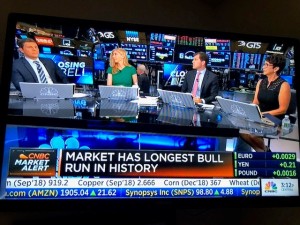Category Archives: buy or sell
Sound Advice in Early 2016 Remains Sound in mid-2017
This piece was published in my weekly column–Your Financial IQ–in The Arizona Republic on January 21, 2016 just weeks prior to the market bottom. Had you taken advantage of the advice: “don’t cave, don’t sell, don’t capitulate…rather this is the time time to upgrade your holdings, you would have enjoyed returns close to 30% as measured by the S&P 500. Hopefully, by buying the stocks to own for a lifetime we advocate, you would have done even better. The markets are volatile once again. Investors are worried stocks are too expensive. The same advice holds true: buy great companies, seek companies that pay a growing dividend and extend your time horizon. Volatility is the nature of the beast.
January 21, 2016: For 25 years, I commuted into San Francisco to work. During the Internet bubble at the end of the end of the 1990s, the traffic grew to epic proportions.
A normally 30-minute drive morphed into an hour, sometimes an hour and a half. Too many cars, too few lanes. The traffic made me crazy, and I drove like it. I was the driver who merged first into one lane and then another to anticipate the flow. Inevitably, once I switched lanes, the traffic slowed and the cars in my previous lane whooshed past. If I shifted back over, the traffic in front of me once again suddenly slowed and I watched another stream of cars whiz by on either side. By trying to anticipate future traffic flows, I inevitably came up short and increasingly frustrated.
On the heels of the worst short-term opening for stocks (ever!), it is important to have a plan, know your risk tolerance and to implement your discipline with conviction. One day I observed that changing lanes didn’t pay. The best strategy was to pick a particular lane and stick to it. I learned not to zig. Or zag. I resisted the lure of chasing the apparent traffic flow, because from my vantage — in the thick of the traffic jam — I lacked perspective so I stuck with my driving discipline and didn’t veer from the plan.
According to Deutsche Bank, the stock market, on average, has a correction every 357 days, or about once a year. Based on research conducted by John Prestbo of MarketWatch, between 1945-2013, the average correction in the DJIA (a decline of 13.3 percent) lasted a mere 71.6 trading days, or about 14 calendar weeks. Sell-offs don’t last forever and provide an excellent opportunity to buy great companies at a discount.
It is important to note that our aversion to loss can often overpower our desire for return. That is why the first of my 11 Intelligent Investing rules cites discipline: Having any investing discipline is better than having no discipline at all; once your investment strategy is established, never deviate.
In other words, in a market like the one we’ve experienced so far in 2016, don’t cave, don’t sell, don’t capitulate. Rather, this is the time to upgrade your holdings.
Recall my Starbucks (SBUX) example. It is important. In April 2007 I bought Starbucks after a 30percent decline to about $31 per share. In December of that year, Howard Shultz returned as CEO and the market cheered with a rally in SBUX’s price.
And then the financial crisis of 2008 hit and the stock declined to a low of around $8 per share. But even at my flawed purchase level of $31 in 2007, the stock has returned 198.8.8 percent versus 56.5 percent for the S&P 500 through Friday. Stick with your plan in good times and bad.
Nancy Tengler is the author of “The Women’s Guide to Successful Investing,” a financial-news commentator and university professor and Chief Investment Officer for Heartland Financial USA. Reach her at nancy.tengler@cox.net.

